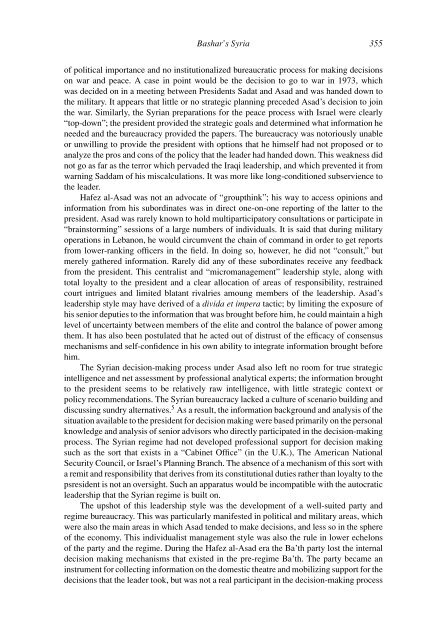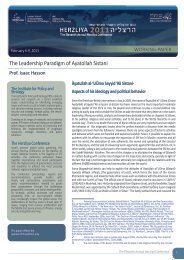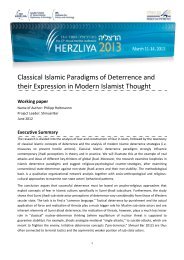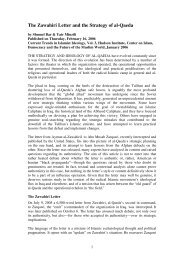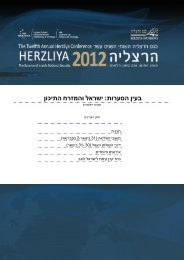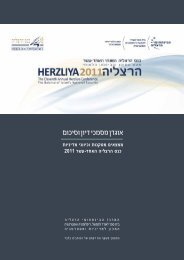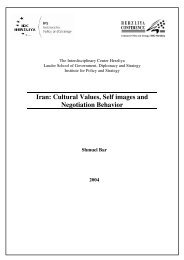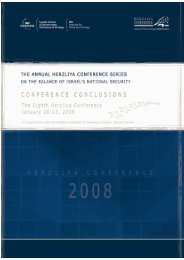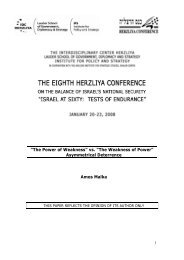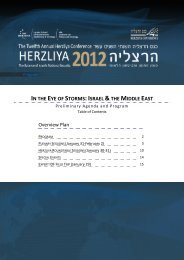Bashar's Syria: The Regime and its Strategic Worldview Shmuel Bar ...
Bashar's Syria: The Regime and its Strategic Worldview Shmuel Bar ...
Bashar's Syria: The Regime and its Strategic Worldview Shmuel Bar ...
Create successful ePaper yourself
Turn your PDF publications into a flip-book with our unique Google optimized e-Paper software.
Bashar’s <strong>Syria</strong> 355of political importance <strong>and</strong> no institutionalized bureaucratic process for making decisionson war <strong>and</strong> peace. A case in point would be the decision to go to war in 1973, whichwas decided on in a meeting between Presidents Sadat <strong>and</strong> Asad <strong>and</strong> was h<strong>and</strong>ed down tothe military. It appears that little or no strategic planning preceded Asad’s decision to jointhe war. Similarly, the <strong>Syria</strong>n preparations for the peace process with Israel were clearly“top-down”; the president provided the strategic goals <strong>and</strong> determined what information heneeded <strong>and</strong> the bureaucracy provided the papers. <strong>The</strong> bureaucracy was notoriously unableor unwilling to provide the president with options that he himself had not proposed or toanalyze the pros <strong>and</strong> cons of the policy that the leader had h<strong>and</strong>ed down. This weakness didnot go as far as the terror which pervaded the Iraqi leadership, <strong>and</strong> which prevented it fromwarning Saddam of his miscalculations. It was more like long-conditioned subservience tothe leader.Hafez al-Asad was not an advocate of “groupthink”; his way to access opinions <strong>and</strong>information from his subordinates was in direct one-on-one reporting of the latter to thepresident. Asad was rarely known to hold multiparticipatory consultations or participate in“brainstorming” sessions of a large numbers of individuals. It is said that during militaryoperations in Lebanon, he would circumvent the chain of comm<strong>and</strong> in order to get reportsfrom lower-ranking officers in the field. In doing so, however, he did not “consult,” butmerely gathered information. Rarely did any of these subordinates receive any feedbackfrom the president. This centralist <strong>and</strong> “micromanagement” leadership style, along withtotal loyalty to the president <strong>and</strong> a clear allocation of areas of responsibility, restrainedcourt intrigues <strong>and</strong> limited blatant rivalries amoung members of the leadership. Asad’sleadership style may have derived of a divida et impera tactic; by limiting the exposure ofhis senior deputies to the information that was brought before him, he could maintain a highlevel of uncertainty between members of the elite <strong>and</strong> control the balance of power amongthem. It has also been postulated that he acted out of distrust of the efficacy of consensusmechanisms <strong>and</strong> self-confidence in his own ability to integrate information brought beforehim.<strong>The</strong> <strong>Syria</strong>n decision-making process under Asad also left no room for true strategicintelligence <strong>and</strong> net assessment by professional analytical experts; the information broughtto the president seems to be relatively raw intelligence, with little strategic context orpolicy recommendations. <strong>The</strong> <strong>Syria</strong>n bureaucracy lacked a culture of scenario building <strong>and</strong>discussing sundry alternatives. 5 As a result, the information background <strong>and</strong> analysis of thesituation available to the president for decision making were based primarily on the personalknowledge <strong>and</strong> analysis of senior advisors who directly participated in the decision-makingprocess. <strong>The</strong> <strong>Syria</strong>n regime had not developed professional support for decision makingsuch as the sort that exists in a “Cabinet Office” (in the U.K.), <strong>The</strong> American NationalSecurity Council, or Israel’s Planning Branch. <strong>The</strong> absence of a mechanism of this sort witha remit <strong>and</strong> responsibility that derives from <strong>its</strong> constitutional duties rather than loyalty to thepsresident is not an oversight. Such an apparatus would be incompatible with the autocraticleadership that the <strong>Syria</strong>n regime is built on.<strong>The</strong> upshot of this leadership style was the development of a well-suited party <strong>and</strong>regime bureaucracy. This was particularly manifested in political <strong>and</strong> military areas, whichwere also the main areas in which Asad tended to make decisions, <strong>and</strong> less so in the sphereof the economy. This individualist management style was also the rule in lower echelonsof the party <strong>and</strong> the regime. During the Hafez al-Asad era the Ba’th party lost the internaldecision making mechanisms that existed in the pre-regime Ba’th. <strong>The</strong> party became aninstrument for collecting information on the domestic theatre <strong>and</strong> mobilizing support for thedecisions that the leader took, but was not a real participant in the decision-making process


